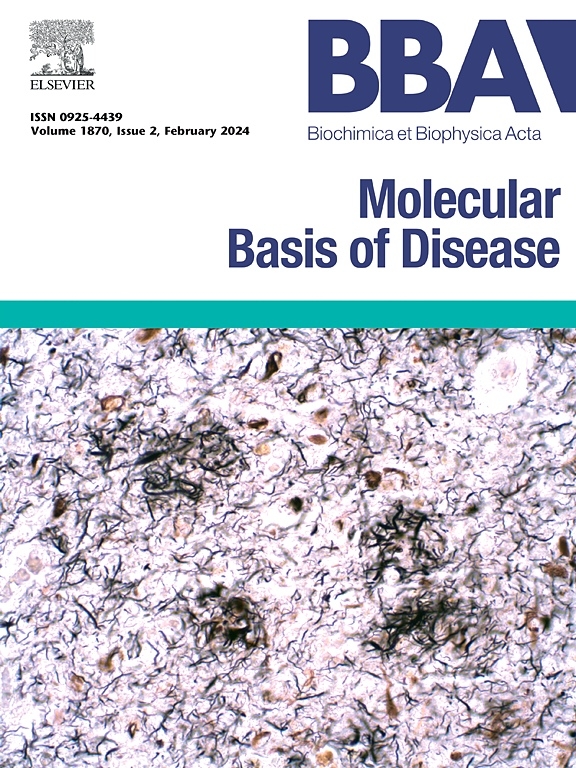癌基因抑制和丙酮酸脱氢酶激酶阻断在耐药NSCLC细胞中的协同作用
IF 4.2
2区 生物学
Q2 BIOCHEMISTRY & MOLECULAR BIOLOGY
Biochimica et biophysica acta. Molecular basis of disease
Pub Date : 2025-08-08
DOI:10.1016/j.bbadis.2025.168014
引用次数: 0
摘要
肿瘤细胞的代谢重编程在癌症进展中起着关键作用,有助于耐药和肿瘤存活。酪氨酸激酶抑制剂(TKIs)通过靶向癌细胞增殖、存活和转移的特定信号通路显示出有希望的临床结果,现在是具有可操作突变的非小细胞肺癌的标准治疗方法。然而,对TKIs的二次耐药仍然是一个重大挑战。在这里,我们探讨了TKIs与葡萄糖代谢抑制剂(二氯乙酸,DCA)联合使用的基本原理,重点是双重抑制致癌和代谢重编程的协同效应。我们选择了3种EGFR/MET/KRAS突变的NSCLC细胞系模型(H1975, H1993, A549),并确定了逆转Warburg效应的最佳DCA剂量(500 μM)。TKIs与DCA (CI <;1,表明协同作用)通过减少葡萄糖消耗来改善氧化磷酸化,改变细胞代谢(~ 50%,p <;0.05), ATP升高(~ 50%,p <;0.0001),特别是mitoATP,由代谢物水平证实。联合用药还能降低细胞增殖(S期p <;0.001),细胞死亡增加(~ 40%,p <;MMP减少0.0001,BIM增加~1.6倍,自噬增加2.5倍),侵袭受阻(突出物减少~3倍)。我们的研究结果表明,DCA在较低剂量下可能通过Warburg效应逆转增强TKIs。肿瘤行为的这些变化导致更高的促凋亡状态,导致肿瘤反应增加,同时,较低剂量减少了替代逃避途径,有助于减少肿瘤侵袭和抵抗机制。这项研究揭示了一种新的潜在的联合治疗方法,以改善靶向癌症治疗方案的临床结果。本文章由计算机程序翻译,如有差异,请以英文原文为准。
Synergistic effects of oncogene inhibition and pyruvate dehydrogenase kinase blockade in resistant NSCLC cells
The metabolic reprogramming of tumor cells plays a critical role in cancer progression, contributing to drug resistance and tumor survival. Tyrosine kinase inhibitors (TKIs) have shown promising clinical results by targeting specific signaling pathways in cancer cell proliferation, survival, and metastasis and are now standard of care for NSCLC with actionable mutations. However, secondary resistance to TKIs remains a significant challenge. Here, we explored the rationale behind combining TKIs with an inhibitor of glucose metabolism (dichloroacetate, DCA), focusing on the synergistic effects from dual inhibition of oncogenic and metabolic reprogramming. We selected three NSCLC cell line models (H1975, H1993, A549) with EGFR/MET/KRAS mutations and determined the optimal DCA dose (500 μM) to reverse the Warburg effect. TKIs in combination with DCA (CI < 1, indicating synergy) altered cell metabolism, by improving oxidative phosphorylation via reduced glucose consumption (~50 %, p < 0.05) and increased ATP (~50 %, p < 0.0001), particularly mitoATP, confirmed by metabolite levels. The combination also reduced cell proliferation (S phase p < 0.001), increased cell death (~40 %, p < 0.0001 less MMP, ~1.6 fold more BIM, 2.5-fold more autophagy) and blocked invasion (~3 fold fewer protrusions). Our findings show DCA potentiates TKIs at lower doses, likely via Warburg effect reversal. These changes in tumor behaviour leads to a higher pro-apoptotic status responsible for an increased tumor response and, in parallel, the lower doses reduced alternative evasion pathways contributing to decrease of tumor invasion and resistance mechanism. This study shed light on a new potential combined therapeutic approach to improve clinical outcomes in targeted cancer therapy scenarios.
求助全文
通过发布文献求助,成功后即可免费获取论文全文。
去求助
来源期刊
CiteScore
12.30
自引率
0.00%
发文量
218
审稿时长
32 days
期刊介绍:
BBA Molecular Basis of Disease addresses the biochemistry and molecular genetics of disease processes and models of human disease. This journal covers aspects of aging, cancer, metabolic-, neurological-, and immunological-based disease. Manuscripts focused on using animal models to elucidate biochemical and mechanistic insight in each of these conditions, are particularly encouraged. Manuscripts should emphasize the underlying mechanisms of disease pathways and provide novel contributions to the understanding and/or treatment of these disorders. Highly descriptive and method development submissions may be declined without full review. The submission of uninvited reviews to BBA - Molecular Basis of Disease is strongly discouraged, and any such uninvited review should be accompanied by a coverletter outlining the compelling reasons why the review should be considered.

 求助内容:
求助内容: 应助结果提醒方式:
应助结果提醒方式:


